The Eurocom Sky X7C (Clevo P775TM1-G) Gaming Laptop Review: True Desktop Replacement
by Brett Howse on August 5, 2019 8:00 AM ESTWireless
Eurocom offers the Sky X7C with your choice of either the Intel Wireless-AC 9260, or the Killer Wireless-AC 1535, which is based on the Intel offering. Both offer similar performance, with the Killer adding in additional software features including the ability to team with the included Killer Ethernet for the Doubleshot Pro, if you want to prioritize your traffic across multiple connections. For this review, we opted for the base Intel 9260 solution.
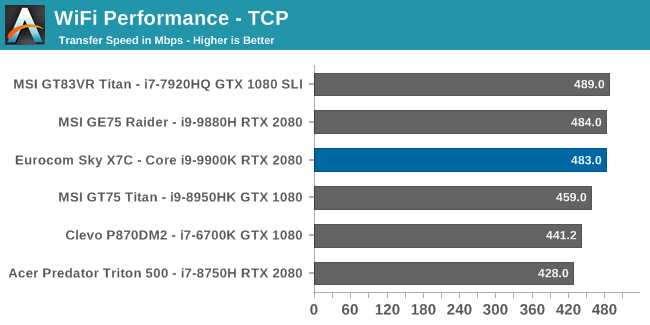
Performance was, as expected, excellent, and the 9260 continues to be the top wireless card of the current generation, with great performance, and a rock-solid connection. If you have a router with 160 Mhz channel support, performance would be even higher, since the connection speed would double from the normal 867 Mbps of a typical 2x2:2 802.11ac solution to 1.73 Gbps.
Audio
The included speakers are smartly arranged so that they project forwards and upwards from the rear of the notebook, and the speaker grilles are visible with the notebook open or closed, meaning the audio would still be the same if the notebook was being used closed while connected to an external display and keyboard. It’s a great design for this class of laptop, where that could easily be the use case.
Sound quality on the stereo Onkyo speakers is surprisingly good, with reasonable midrange and bass thanks to the 2.5W Subwoofer, with the caveat of course that all laptop speakers are poor compared to proper standalone models. The speakers reached 80 dB(A) measured one inch over the trackpad, with no clipping or distortion even at maximum volume.
The Sky X7C also features four 3.5 mm jacks, offering audio out, audio in, microphone in, and SPDIF. This is more common on the large form factor gaming laptops, where the additional audio inputs may be useful for streaming. The device leverages the SoundBlaster X-Pro Gaming sound card.
Thermals
Packing a desktop CPU into a notebook computer is not for the faint of heart, and cooling this, coupled with the RTX 2080 can be a challenge. With a combined power draw that can close in on 300 Watts even at stock frequencies, that’s a lot of heat to remove so proper cooling is important. Luckily, Clevo has been in the DTR game for some time and their chassis have proven themselves to be up to the task.
With a 1.6-inch thick notebook, there’s extra capacity for heatsinks, and although the Clevo based Eurocom Sky X7C is somewhat light for a Desktop Replacement, it’s still hefty at about 4 kg / 8.5 lbs. The extra size of a 17.3-inch notebook also provides room for larger fans to help move air without the fan noise becoming a jet-engine like pitch.
To see how the Sky X7C handles the load, the laptop was loaded up for an extended duration. As we’ve seen in past Clevo DTRs, they are designed to handle the load, and the X7C was able to cope without much difficulty. Over the duration, the GPU was pretty much rock-steady at 1650-1680 MHz, with a temperature right at 81°C. There was no degradation in frequency over time, nor did the temperatures continue to rise past that point.
The notebook was also run with a pure CPU stress test, and the results were astounding for a notebook. The CPU spikes to 157 Watts under max load before settling into a steady state of about 120 Watts, which is well above the rated TDP even at stock speeds – a trend that is common on high-core count Intel processors. Temperatures at max load were around 87° but once again were never trending up beyond that point, and the CPU was able to maintain between 4100 and 4200 MHz on all cores without throttling further. That level of performance is certainly a step above any of the typical 45-Watt processors in most gaming notebooks.
The downside of all of this power is of course noise, and the Eurocom Sky X7C reached around 60 dB(A) measured one inch over the trackpad after extended use. There is no throttling inside, but the acoustics are definitely on the noisy side. As a comparison, the last Clevo based DTR we tested was the P870DM2, and it only reached 49.5 dB(A) under load, although it weighs a whopping 50% more than this notebook. As is typical with gaming notebooks, a good set of closed back headphones are somewhat of a necessity. Luckily when not under load, the fan noise is almost completely silent, although the 780-Watt PSU fans are somewhat audible, adding to the total noise.
Software
As is typical of a gaming laptop, there’s included software to configure the settings under the hood, as well as the keyboard backlighting and macros. Since this is a Clevo based device, it comes with the Control Center software which provides quite a bit of functionality and monitoring capabilities.
You can adjust the CPU and GPU offsets from within Control Center if you’d like right from the main page. The CPU adjustments give quite a wide range of settings, from the Ratio override for each core, to allowing the Turbo settings to be configured along with the steady state power draw, which is by default set at 120 Watts, and lines up exactly with the power draw recorded during our CPU loads.
You can of course also adjust the fan profiles, and configure fan settings for different tasks, such as entertainment and performance.
The LED lighting settings are very basic, since this notebook only supports three RGB zones rather than per-key settings like some of the more expensive competition, but the macro settings are available as expected.
The functionality is all there for Control Center, but if it has one major downside, it’s the looks. The user experience isn’t great, and it’s not very clean looking software. As tends to be the case with everything about Clevo, it’s function over form.


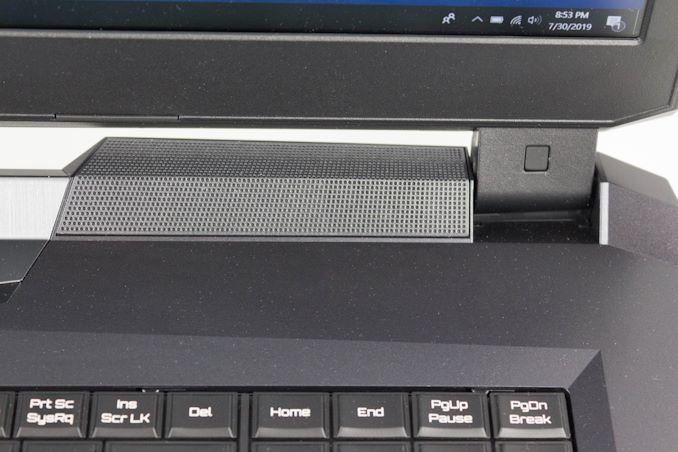
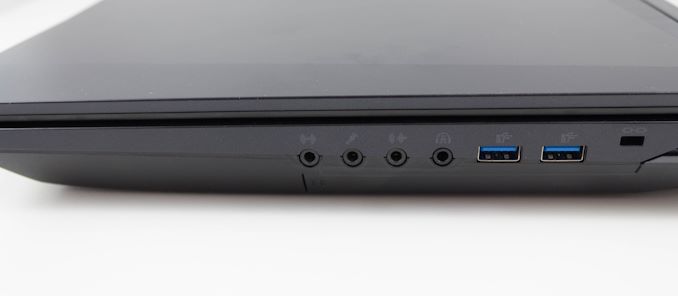
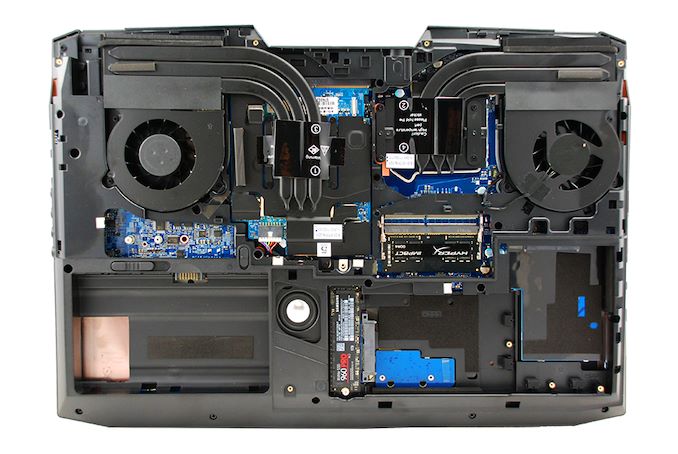
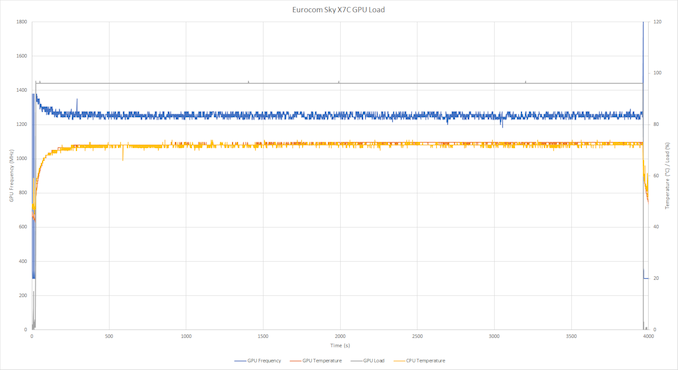

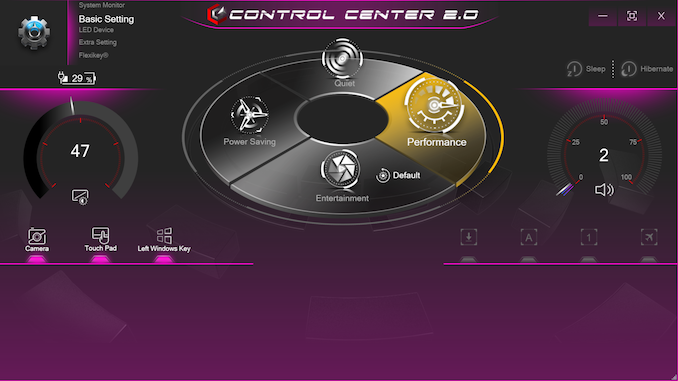
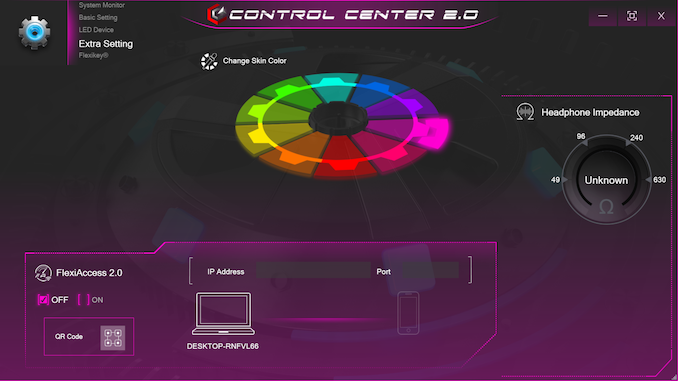








46 Comments
View All Comments
p1esk - Monday, August 5, 2019 - link
I love the option of 1440p at 120Hz! Hope to see it in normal laptops (perhaps new MBPs can lead the way to improved refresh rates?)HollyDOL - Monday, August 5, 2019 - link
Since the article title talks about 'true desktop replacement', could we get price and performance comparison to desktop with "same" parts? ie. DDR4-3000 + 9900K + RTX 2080...Brett Howse - Monday, August 5, 2019 - link
Our GPU bench is currently an i9-9900K as well. As a comparison I got 116 FPS on Shadow of the Tomb Raider, and Ryan got 114.6 with the desktop version, so the performance seems similar. Unfortunately we don't have a lot of overlap on our tests though because Ryan is able to keep GPUs and benchmark them on new suites whereas laptops have to go back to the manufacturers so I don't rotate the tests as heavily since every time I add a new test it starts out with zero results to compare against.Is there a particular title you'd like to see compared against other than Shadow of the Tomb Raider?
HollyDOL - Tuesday, August 6, 2019 - link
nice, thanks...Compile Chromium (time) test would be nice...
or in general anything that puts the machine under high sustained stress for longer period (45mins+)...
craz8 - Monday, August 5, 2019 - link
I have one of these laptops - a Sager branded one.It really is quite heavy, and the 330W power brick is equally beefy - I selected the RTX 2070 to avoid needing double power bricks. I do use this on my lap, but the power plug at the back falls out a lot in this configuration. It's not a very secure connection. Since it's at the back, the only way to notice is that suddenly the CPU is running at 1.3Ghz instead of 4+
I almost always run this in Quiet mode, as the fans are almost silent in this mode. When I'm stressing the machine, the CPU clocks down to about 3.4-3.6 Ghz, which is still good enough for the work I do on it. If I run in performance mode, the things I run go a little faster, but the fan noise is not worth the extra speed.
There really isn't enough cooling for Nvme drives. Even small amounts of writing to them immediately pushes the temps to 90+, and there's no room for extra heatsinks to help with this.
I have the 4K screen, which seems pretty good, but if you dual boot into a Linux OS, the bootloader screen is hilariously small, and some versions of Linux have poor scaling options
I mostly use this on my desk, and it (or Windows 10) really doesn't like my CalDigital TB3 dock. Luckily, everything plugs into the chassis (unlike recent Apple hardware)
I don't play games on this, so barely use the GPU (RTX 2070). I'd love to have options to push more power and cooling to the CPU whilst scaling them back to the GPU without having to poke at the values manually.
Overall, I like mine, but it does have quirks.
Alistair - Monday, August 5, 2019 - link
I think you'd be much better off with a (I hate to say it) nVidia creator laptop, or a 9880H/9980HK laptop with a 120/144hz Gsync IPS screen. We need a comparison with Clevo of the MSI Stealth and Raider and Titan.https://www.newegg.com/matte-black-with-gold-diamo...
Brahman05 - Monday, August 5, 2019 - link
I have sager's version of the x9e2 with a 7700k and 1080sli and the same 1440p panel, and the panel is both one of the best and worst parts in the thing. One thing not mentioned in this article is the gtg does not really support the refresh rate, but by reporting a 120hz refresh it at least still cuts down on input lag. I really have no complaints though. When I got it I had a mobile lifestyle and had the money for it, my only two real gripes are ZEN and RTx. Not 3 months after I got the thing AMD goes and makes 8c16t a thing and even if the architecture is pretry much the same from the 6700k to the 9900k the productivity of the same class chip is now double. And with RTX going to NVLink for an sli bridge Nvidia has axed mobile sli due to the complexity involved in producing that type of connector. So this X7c is really the way to go anymore. Damn you progress!LsRamAir - Monday, August 5, 2019 - link
No Overclocking detail... bahhhh! Pushing these DTRs to the max that their cooling allows for is what at least half of their buyers do... Next time, yes please! (Especially in the wake of similarly spec'd DTR machines burning out under mild OC's, which SHOULD NOT HAPPEN, it would be nice to know if this SKY is also part of the bad choices group.)peteraustin - Tuesday, August 6, 2019 - link
Amazing article https://www.anandtech.com/ you should definitely read it in your spare timehennes - Tuesday, August 6, 2019 - link
I recently got this laptop as a replacement for a 10 1/2-year-old laptop. I wanted a full-sized keyboard, which means 17” or larger. Potable means 17” really it the limit. And 17” is perfect for 2k screens.The Sky X7 was one of the few which offered that and it had all my desired other connectivity (multiple NVME, multiple DP out, a few fast USB ports, thunderbolt, …
What really was surprising is how few other there are. Many with low res displays (1920x1080) which makes sense for gaming. Some with 4K displays future proof but quite small on a 17” display.
That made the X7C almost the only sensible choice.
And from an engineering view the thicker than average body was also very attractive. As were the looks. Form over function simply looks good, while designed stuff tend to look odd and twisted to me.
The only thing it lacks for me is more battery capacity. Lugging the large charger around is not fun and two battery slots (or 2x 80) for airplane use would have been my choice if it was offered.